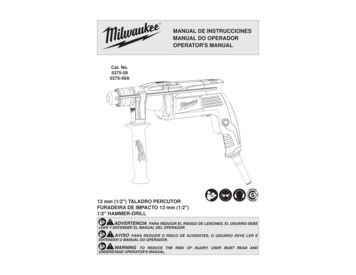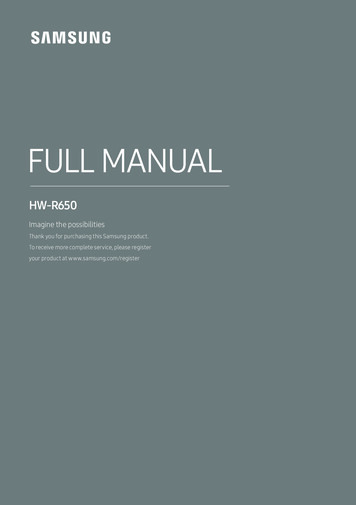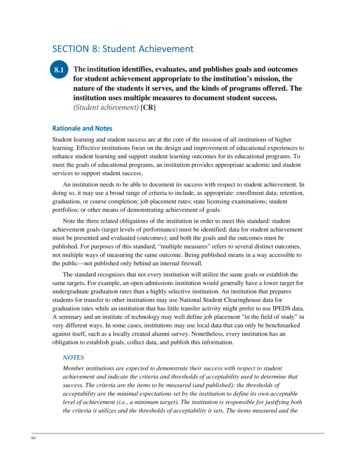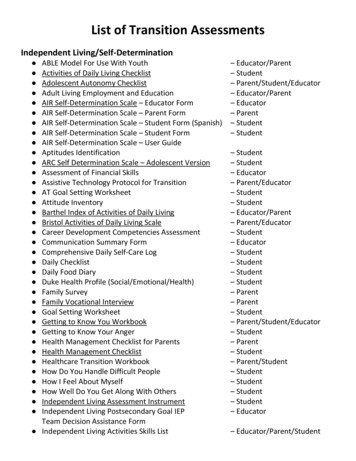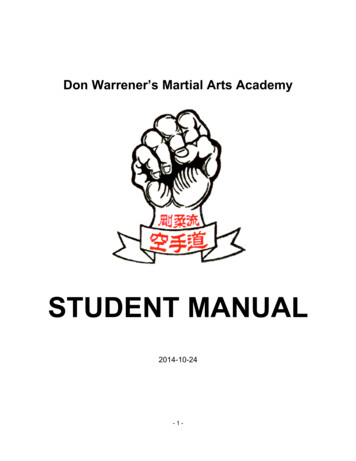
Transcription
Don Warrener’s Martial Arts AcademySTUDENT MANUAL2014-10-24-1-
ContentsIntroduction.3Terms.4Dojo te.16Gradings.17History.18Goju-Ryu Crest.20Student Creed.21-2-
IntroductionCongratulations on your commitment to training!This student manual is designed as a guide for students who are new to the martialarts, as well as a reference tool for experienced students along the road to black belt.It should be noted that the information in this manual ranges from what you will needto know from Day 1 onwards, so don’t feel intimidated by the more advanced levels.Everyone learns at their own pace and self-improvement is a better yardstick thancomparing yourself to others. Train hard at all times.For the first few weeks of your training, give yourself a chance to get used to themovements in karate. Be sure to not over-exert yourself. Even those in excellentcondition will no doubt find that they are using their muscles differently. Always stretchout well at the start of class and take care to avoid injuries. A good rule of thumb is‘stretch what you strengthen and strengthen what you stretch’.There is a wealth of new things to learn in karate. The martial arts are steeped intradition which has been passed down over generations. As you progress, be sure topick up as much information as you can about your art. There are many very goodbooks available for training aids, historical references, and philosophical theories. Askyour head instructor about suggested reading materials.Always train in a serious light. Many students find that the days which they feel theleast like coming to karate are the days which they feel the best afterwards.Above all else, enjoy your training!“The ultimate aim of karate lies not in victory or defeat, but in theperfection of character of its participants.”- Gichin FunakoshiDon Warrener’s Martial Arts Academyis Brantford’s Oldest Full-Time Traditional Karate School.It features world class programs and has been well represented locally, nationally andinternationally in competition.-3-
TermsThere are many new terms to which you will be introduced in the martial arts. Here is apartial listing of the ones that you will come across early in your training.Karate-Do – Empty Hand WayLiterally translated from the Japanese words‘Kara’ meaning ‘empty’, ‘Te’ meaning ‘hand’, and ‘Do’ meaning ‘way’. This refers to theability of its students to defend themselves without the use of weapons.Goju-Ryu – Hard Soft Style Literally translated from the Japanese words ‘Go’meaning ‘hard’, ‘Ju’ meaning ‘soft’, and ‘Ryu’ meaning ‘style’. Our style of karate isbased on the ideals that combining hard and soft techniques together provides themost effective system of self defense.Dojo – Training Place Literally translated from the Japanese words ‘Do’ meaning‘way’ and ‘Jo’ meaning place, a ‘dojo’ refers to ‘the place where one walks the way’.This basically represents anywhere that an individual studies their karate. It can be aformal martial arts school, a church basement or even a park if you study outside. Inthis case, the field and the open sky are your dojo.Gi – Uniform‘Gi’ is the shortened version of ‘karate-gi’ meaning ‘karate clothing’or ‘keiko-gi’ meaning ‘practice clothing’. Although a beginner’s gi may be made of apolyester blend, a traditional karate-gi is made of heavyweight cotton and only comesin one colour - white.Obi – BeltThe one part of a student’s uniform which receives the mostattention is the belt. Traditionally, there were no coloured belts. Everyone had a whitebelt which became soiled over the years of training. The longer you trained the blackerit got. Now, coloured belts help to distinguish between progressive levels of trainingand range in full and half colours from white to black. In honour of tradition, you shouldstill never wash your belt.Sensei – TeacherLiterally translated from the Japanese words ‘Sen’ meaning‘precede’ and ‘Sei’ meaning ‘life’, a Sensei is essentially ‘one who has gone beforeyou’. At the very least, a Sensei is the head instructor of your school. Additionally, agood Sensei represents an experienced teacher, a valued advisor, an unrelentingenforcer, a compassionate mentor and more. The Sensei/Student relationship isdifficult to completely define, but that said, it should always be treated with respect.-4-
Kilskai – AttentionThis command is used to call the students to attention duringclass. It tells the students to immediately cease what they are doing and stand withtheir feet together and their arms at their sides. This command is almost alwaysfollowed directly by ‘Rei’ and ‘Osu’.Rei – BowThe bowing in karate represents humility, trust and respect. Infeudal Japan, the samurai would bow before each other to convey the trust that theother will not behead them with their sword. This is the same trust that must berecognized when working with partners during class. Although the odds of losing yourhead is quite slim, it’s nice to know that your partner is willing to respect the fact thatyou are allowing them to use you for practice.Osu (Os) – Acknowledgment‘Osu’ is a term which is widely used to mean‘yes’, ‘okay’, or ‘I understand’. The closest translation of the phonetic charactersmaking up the term is ‘a pledge to endure’ or ‘give one’s best effort’. This is normallysaid after bowing or after specific instructions from your teacher.Shomen – The Front of the Dojo Literally translated from the Japanesewords ‘Sho’ meaning ‘proper’ or ‘correct’ and ‘Men’ meaning ‘side’ or ‘face’, theshomen is the designated front side of the dojo. The shomen can be any side of thedojo (or ring) which students do not enter and exit from. When lining up in class, thestudents face the shomen, which is where the head instructor sits. Normally, theshomen is identified by a small shrine with pictures of karate founders which aid inrepresenting the spirit of the dojo.Mokuso (Mukso) – MeditationLiterally translated from the Japanese words‘Moku’ meaning ‘silence’ and ‘So’ meaning ‘to think’, mokuso is a time in which thestudent can clear their mind of outside thoughts and concentrate on their training.Ashimai (Hajime) – BeginUsually used to start a sparring match or toinstruct a student to start their kata, ‘Ashimai’ simply means ‘begin’.Yemai (Yame) – Stop‘Yemai’ is a command used to call to a halt whateveractivity is being performed by the students. For drills, stretching and most everythingelse, it simply means ‘stop’, but in sparring matches a student must be able to stoptheir technique immediately when ‘Yemai’ is called.Kiai – YellIt is generally accepted in Asian culture that there is a force whichflows through everyone. This is referred to as ‘ki’. (Also ‘chi’ or ‘qi’.) A kiai is used bymartial artists to focus this energy on a particular technique. If performed properly, akiai will be forced out by exhaling from the lower abdomen as opposed to the lungs.-5-
Kihon – BasicsJust as most everything in the world can be broken down toits fundamentals, so to can karate. ‘Kihon’ encompasses all of the building blocks ofkarate - moving, blocks, strikes, kicks and most importantly, stances. Basics are thefirst things that you learn as a white belt, and are the same things that you striveto perfect as a black belt. Good, solid basics are invaluable in karate.Kata – FormsA ‘kata’ is a pre-arranged series of movements simulatingcombat against multiple attackers. All katas in Goju-Ryu have been handed down overthe generations and therefore all share virtually the same schematics from club toclub. That said, there is certainly room for interpretation. As you progress to the higherbelts, you develop your own style in your katas which will make your forms uniquefrom someone else’s. Katas are excellent training tools because it is the only timewhen a student can perform techniques at full power and intensity without the risk ofinjuring a partner.Kumite – Fighting‘Kumite’ is often used interchangeably with ‘sparring’, andrefers to students who train one on one with a partner. It may be structured trainingdrills as in ‘Ippon kumite’ (one point fighting) or free-style sparring as in ‘Jiyu kumite’.Regardless, there should always be an emphasis on safety and respect for yourpartner while practising or competing in kumite.Kime – FocusOne of the most important aspects of training is to learn howto ignore distractions and concentrate on your techniques. The importance of good‘kime’ is obvious in kumite, but equally important while performing kata and kihon.Focusing on what you are doing today will pay great dividends over your years ofmartial arts training.Bunkai – Application ‘Bunkai’ refers to the explanations of certain techniques,usually derived from katas. The forms contain many different types of attacks anddefenses and studying your katas would not be complete without an understanding ofthem. Some of the movements in a kata are easily recognized, while others requiresome additional research. Many of the higher katas also contain intricate, ‘hidden’meanings which are known as ‘kakushita’.Counting to ineTenRukoShichi (Nana)HachiKu (Kyu)Ju (Jyu)It should be noted that the English spelling of some of these terms may vary depending on the source. The mostpopular interpretations have been used where possible.-6-
Dojo EtiquetteAdmittedly, it may be a little intimidating when you first enter a dojo. Traditionally, youwill learn the proper protocol over time with the assistance of those who have trainedbefore you. However, here are some basic rules and practices which you will need topick up quickly.RespectNow that you are a student, you should always address the head instructor as Sensei,both inside and outside of the dojo. Other black belt instructors are referred to asMr. or Mrs. or Miss . There are several senior black belt instructors who arereferred to as 'Sempai' or 'Sensei'.Whenever you enter or exit the dojo, always turn to face the dojo and bow.Remember that you are a representative of your school both in and out of the dojo.Always conduct yourself accordingly.PresentationLearn the correct way to wear your gi and to tie your belt. (Keep asking until you aresure that you are able to do it correctly every time.) Girls and ladies are suggested towear a plain white t-shirt tank top under their gi top. Always keep your uniform cleanand in good repair. No one wants to train next to someone with a filthy gi! If you needto adjust your gi or re-tie your belt while in the dojo, always turn away from the front ofthe dojo and kneel down.Personal hygiene is very important. Often times, training drills require the use of apartner. Always be sure to keep your hands and feet clean, nails trimmed and yourhair kept in a manner that will not interfere with your training. Remove all jewellerybefore class as it may become damaged or cause injury to yourself or others.Traditionally, jewellery is not allowed in a dojo because it often represents a level ofsocial status which should not have an affect on your training. Everyone in the dojo isthere to learn - on an even playing field.LogisticsParking is available in our lot, and at the strip mall on the South side of Charing Cross.Parking on Hill Ave. is monitored for compliance with city by-laws.Always remove your shoes when entering and keep the change rooms and lobbyclean.-7-
Although you won’t need to have your own safety equipment immediately, they areessential for safety during Kumite. You should accumulate some by the time you areready for you first grading. A complete set consists of a mouth-guard, groin protector,head gear, hand pads, foot pads and optional shin pads, and is available at the frontdesk. Consider labelling your items with your name.Our club is a non-smoking facility. No food, beverage or gum chewing is allowed onthe dojo floor. Bring a water bottle and small towel.If you arrive early, consider warming up or stretching downstairs.Children should remain upstairs and supervised until their class starts. Parents shouldaccompany their children to and from class.Regularly check the monthly calendars at the dojo and on the web sitehttp://dwmaa.com/calendar.html to know when classes may be cancelled due togradings or holidays. News are often announced on Facebook and by email, so keepcontact information current.Always remember to keep your membership current by paying your membership feeson time. This helps to meet the financial commitments of the dojo, which allows us allto have somewhere to train!-8-
ClassesClasses are scheduled at a variety of times throughout the week. Be sure to knowwhen your classes begin and end and always arrive with enough time to get changedand ready for the start of your class. In the event that you arrive late and your classhas already started, get your uniform on quickly and kneel at the entrance to the dojountil you are invited in by the instructor.Always let your instructor know before the class begins if you have any injuries orillnesses that will affect your training that day. Listen to your body. Training hardshould produce some sore muscles, discomfort and perhaps bruising - but not pain.Train smart. Parents should inform instructors of any special concerns about theirchildren.As with many things in karate, all classes begin and end in the same way. Studentsline up in belt order (with higher belts to your right) facing the front of the dojo. Theinstructor is directly across from the students and the highest belt takes the bo. Thefirst command is ‘Shomen ni rei’ in which everyone bows to acknowledge the foundersof our style of karate. The instructor always bows first and the remainder of thestudents bow in order from highest belt to lowest. The second command is ‘Sensei nirei’ in which the instructor bows to the students and the students bow to the instructor.‘Mokuso’ is the start of a moment of meditation in which you lightly close your eyesand breathe in through your nose and out through your mouth. This is a good time toclear your mind of everything outside of the dojo and concentrate on your training.After mokuso, we finish with another ‘Sensei ni rei’. This traditional bowing should notbe considered as demeaning or subservient in any way. It is an acknowledgement ofthe relationship between instructor and student. That is why the instructor always bowsfirst. Without their students, they would not be an instructor.If for some reason you need to leave the class, always raise your hand to get theinstructor’s attention and ask to be excused. Never leave the dojo without permission.Higher belts are encouraged and expected to assist lower belts when asked. The bestway to really learn something is to teach it to someone else. However, you shouldnever teach any new techniques or forms to lower belts without the permission of thehead instructor.Always train in a serious light. Be sure to really understand what it is that you aredoing and why. Take care to ensure safety and control at all times. Students who arenot at the dojo to train seriously may be asked to bow out.-9-
Remember that your actions may hinder the ability of other students to train effectively.Always pay attention and listen carefully to your instructor at all times.Don’t train with strangers - get to know your fellow students. Whenever sparring orworking in partner drills, you should always know the name of the person you aretraining with. After all, you are allowing each other to perform techniques onyourselves which require a certain degree of trust! Many good friendships can bedeveloped through the martial arts.It is important to note that different instructors may vary slightly in how techniques arepresented. In the event that an instructor demonstrates something that is different thanhow you have been previously taught, always accept their method while in their classand, if still unsure, question them politely afterwards. It would be considered the heightof arrogance to suggest that your instructor is wrong, simply because they dosomething differently than you do.Take full advantage of seminars. Highly skilled and experienced martial artists fromother cities (and countries) are occasionally invited to host in-class seminars for thebenefit of those that attend. These seminars are ‘working classes’ in which you bringyour gi and train while you learn. There is a huge amount of information available atthese events and you don’t need to be a higher belt to take advantage of it! The keyhere is this - in order to attract other excellent martial artists to come to our club, weneed to support them when they agree put on these sessions. Nothing is worse thanhaving the best available instructors commit to fly in to host a seminar, only to havepoor attendance from our students.Tournaments from other clubs which practise our style of karate will be postedoccasionally in the lobby. Although competing in tournaments is not mandatory, lowerbelts should consider attending a tournament early in their training. Experience gainedfrom competing in (and preparing for) tournaments can be invaluable. Remember thatyou will only be competing with people in your age range and belt category. Attendingcompetitions as a white or yellow belt will ensure that you are in a division of peoplewho also have little or no tournament experience. Don’t forget, tournaments aredesigned to be fun!- 10 -
ChildrenObviously, children and adults learn new skills and responsibilities at different rates.From a teaching standpoint, children should not be considered as just ‘small versions’of adults. They deserve special consideration. Therefore, there are many differenceswith the training schedules of kids. First of all, classes are divided into concentratedage groups which allow students to train with others of similar size and level ofmaturity. The younger student classes will be focused more on developing suitablebehavior and listening skills - in addition to a great deal of fun! Progressing through theages, students learn to develop patience as their technical skills improve. Olderchildren can begin to train with more of an emphasis on the physical aspect of themartial arts. Eventually, teenagers will be asked to join the adult class schedule.Although children cover the same basics and forms as adults, they will do so at a pacewhich is geared more to their personal development. To alleviate long periodsbetween belt graduations, the children’s program uses a series of belts with full andhalf colours. For example, a new student would progress from white belt to halfwhite / half yellow, before obtaining a full yellow belt. There are also two additional beltcolours, red and purple, which are not used in the adult program. As the children workthrough the requirements of each level, progress is marked with a system of stripes ontheir belts. From an instructional viewpoint, these stripes help to group togetherstudents of similar skills within a specific rank. They also act as incentives betweengradings to let the children know how they are progressing. The stripes represent thefollowing.BlueStudent has shown progress at the basics in the current level.YellowStudent has learned the required basics at the current level.RedStudent has learned the schematics of their new kata.GreenStudent has developed a good form in their kata.BlackStudent has been invited to the next grading.Finally, it should be noted that full black belts represent those who are recognized asinstructors. With this in mind, black belts are students who have not only trained in thephysical techniques of karate, but also possess the maturity which only comes with acertain amount of life experience. Therefore, full black belts are reserved only foradults. Younger students who have met the criteria will be presented with a juniorblack belt and will be invited to grade for a full black belt when they become adults.- 11 -
KihonHere are the translations of the majority of terms which will be used in Basics.(Remember that not all of these techniques will be required by lower belts, but keep inmind that you may be exposed to them at any time.)Stances (Dachi)Heiko dachiZenkutsu dachiSheko dachiKumite dachiSanchin dachiNeko Ashi dachiKokutsu dachiNatural stanceForward leaning stanceSumo stance (Horse stance)Fighting stanceHourglass stanceCat stanceBack stance (‘T’ stance)Blocks (Uke)Gedan baraiChudan (Uchi) ukeJodan (Age) ukeHariatoshiMawashi ukeKake ukeSoto ukeKakato ukeTeisho ukeHiza ukeLow blockMiddle blockHigh blockThree point blockRoundhouse blockHooking blockForearm blockChicken head blockPalm heel blockShin blockStrikes (Zuki and Uchi)Gyaku zukiOi zukiKizama zukiEmpiRekkan (Uraken)TeishoNukiteHaitoTetsuiShutoNi zukiMawashi zukiReverse punchLunge punchLead hand jabElbow strikeBackfistPalm heel strikeSpear hand strikeRidge hand strikeHammer fistKnife hand strikeDouble fist punchRoundhouse punch- 12 -
Kicks (Geri)Mae geri keageMae geri kekomiYoko geri keageYoko geri kekomiMawashi geriMikasuki geriKake geriMae tobi geriAshi baraiUshiro geriFumi komi geriKensetsu geriHiza geriYoko tobi geriUshiro tobi geriWheel kickIron BroomAxe KickFront snap kickFront thrust kickSide snap kickSide thrust kickRoundhouse kickCrescent kickHook kickJumping front kickFoot sweepBack kickStomp kickJoint kickKnee thrustFlying side kickJumping back kickJumping spinning kickSweeping kickHeel kickMiscellaneousMawateKakiwake ukeYoiMakiwaraTurningWedge blockReadyTraining boardPoints on BasicsStances are the most fundamental techniques in karate. Without a strong foundation,strikes, blocks and kicks will have minimal effect. The most important point toremember on stances is that‘Power is rooted in the feet, developed by the legs and guided by the hips.’Blocks are almost always performed with the lead hand, leaving the power side backto deliver a strike. In many cases, the most effective block is simply to move out of theway.Strikes consist of punches as well as open hand techniques and can be delivered withthe emphasis on speed, power or both.Kicks are powerful techniques which, with practice, can be delivered to all areas ofthe opponent. For good control, improving your balance is the key.- 13 -
KataKata are practised in all Japanese martial arts (kendo, judo, etc.), but karate is the onlyone where kata are performed individually. There are forms which are studied rightfrom white belt and new forms are added at each full belt level above. Virtually everytechnique used in karate is represented in the katas. When performing a kata, itshould be announced with feeling and performed with full intensity using the bestbasics you are capable of. Your focus should be unwavering and nothing shoulddistract you. For this reason, you should never stop in the middle of a kata.Points on KataThere are six points which need to be incorporated into your katas. They are.EyesLook where you are headed before you move.PaceLearn the proper rhythm of the kata. This is usually set for the lowerforms, but open to interpretation in the high forms.BreathingIt is surprising the number of times you will need to be reminded tobreathe. Inhaling and exhaling at the proper points is an importantpart of everything you do in karate.FocusMaintain your concentration on what it is that your are doing. Thatsaid, you should be able to perform a kata without actually ‘thinkingabout it’.TechniqueEverything comes back to basics. Every stance, every strike, everykick - execute them to the best of your ability.KiaiRemember, you are simulating a fight against multiple attackers.Learn the proper kiai points in your katas and yell them out!When standing in mokuso before announcing your kata, your left hand should alwayscover your right hand. In Japanese culture, the right hand represents an aggressiveweapon and is therefore covered out of respect for your opponent. In Goju-Ryukarate, all kata begin and end on the same spot. This symbolizes a central belief thatall things, including life itself, end in the same way in which they began.- 14 -
Kata Requirementschildren beltsadult er)katatranslationTaikyoko Gedan(first 8 moves)first course low blockTaikyoko Gedan(full 20 moves)first course low blockTaikyoko Chudenfirst course middle blockTaikyoko Jodanfirst course high blockTaikyoko Mawashi-Ukefirst course roundhouse blockTaikyoko Kake-Ukefirst course hook blockGekisai Dai Ichiattack and smash part oneGekisai Dai Niattack and smash part twoSaifadestroy and defeatSanchinthree battlesSaifadestroy and defeatTenshorotating palmsSeienchin(first half)attack, conquer, suppressSeienchin(full)attack, conquer, suppressSanchin-Tenshothree battles, rotating palmsSanseiruthirty six movesSanseiruthirty six movesSanchinthree battlesSanchin-Tenshothree battles, rotating palmsShi Sho Chinfour battlesSeisunthirteen handsSeipaieighteen handsKururumfahold and destroySuparumpeione hundred eight- 15 -
KumiteUntil the mid 1900’s, kumite consisted of stationary partner drills which concentratedon singular attacks and defenses. Modern karate has developed a system of ‘freestyle’ fighting which allows students to move about and throw a wide variety oftechniques and combinations. Free-style sparring is likely the best way to work ontiming, distancing and reflexes. It is also generally accepted as the most interestingelement of karate from a spectator’s viewpoint!Points on KumiteThere are as many different styles and theories of fighting as there are students. Theidea is to find one that works well for you. Take into consideration your size, flexibility,speed and strength when practising your kumite. All these things, and more, will affectwhich techniques you add to your arsenal. Be sure though, not to discount variouscombinations or moves without trying them repeatedly. The dojo is a place to learndon’t think that having a point scored on you is a bad thing! Learn from your partnerand above all else, check your ego at the door.Contact in sparring is inevitable and encouraged if done properly. Always be sure toadjust your level according to the size and ability of your partner. Higher belts shouldspar at a level just above where the lower belt is fighting. Neither person would learnanything if a higher belt was to devastate a lower belt with a series of advancedtechniques. For safety sake, sparring gear should always be worn, especiallymouthguards and groin protectors. Although kicks below the belt are not allowed atany level, contact can occur and whatever money spent on protection will pay for itselfmany times over. At lower belt levels, there is no contact allowed to the head and it isbest to pull your kicks and punches short of contact to the body. It takes quite a whileto become comfortable with being able to strike to the body with full speed in order tomake contact but not injure. At higher belt levels, body contact is not only allowed butrequired. There is limited contact to the head, but not to the face. Foot sweeps arereserved for advanced belts only.Sensei Yamaguchi’s Five Key Ingredients1.2.3.4.5.Always be in the best shape you can possibly be in.Always strike with total commitment.You must have a calm mind.See through your opponent’s moves.React as quickly as possible to your opponent’s moves.- 16 -
GradingsGradings are an important part of your martial arts training. They mark levels ofachievement along the way. Originally in karate, there were no belt colours andtherefore no gradings. Your regular classes were your gradings. In essence, that is stilltrue today. Everyone who attends a grading is there by invitation from their Sensei,based on their time at rank, performance, attitude and level of commitment in theirregular classes. If you were not ready to grade, you would not have been invited.However, that is by no means a guarantee of passing. You will need to get up in frontof a panel of black belts and demonstrate the requirements for progression to the nextbelt level. Gradings involve five components - basics, kata, kumite, self defense andquestions. Obviously, they range in difficulty and length from white belt to black belt.Those who are grading for higher belts will be responsible for everything which theyhave studied from white belt up to their current level. Keep in mind that gradings arebased on personal achievement and not on comparison to others. True, there is acertain standard which must be met, but that level will be different from
formal martial arts school, a church basement or even a park if you study outside. In this case, the field and the open sky are your dojo. Gi – Uniform ‘Gi’ is the shortened version of ‘karate-gi’ meaning ‘karate clothing’ or ‘keiko-gi


